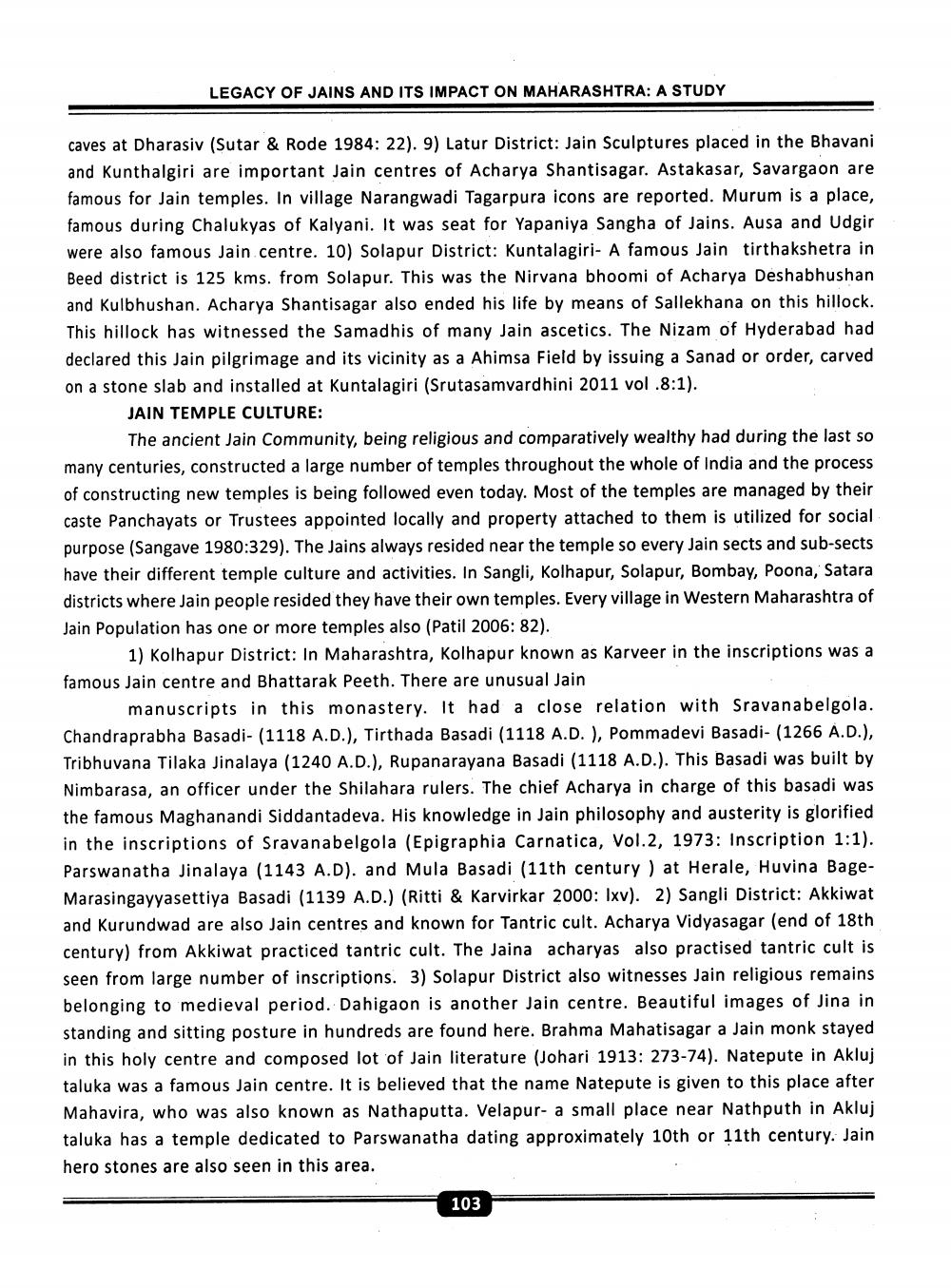________________
LEGACY OF JAINS AND ITS IMPACT ON MAHARASHTRA: A STUDY
caves at Dharasiv (Sutar & Rode 1984: 22). 9) Latur District: Jain Sculptures placed in the Bhavani and Kunthalgiri are important Jain centres of Acharya Shantisagar. Astakasar, Savargaon are famous for Jain temples. In village Narangwadi Tagarpura icons are reported. Murum is a place, famous during Chalukyas of Kalyani. It was seat for Yapaniya Sangha of Jains. Ausa and Udgir were also famous Jain centre. 10) Solapur District: Kuntalagiri- A famous Jain tirthakshetra in Beed district is 125 kms. from Solapur. This was the Nirvana bhoomi of Acharya Deshabhushan and Kulbhushan. Acharya Shantisagar also ended his life by means of Sallekhana on this hillock. This hillock has witnessed the Samadhis of many Jain ascetics. The Nizam of Hyderabad had declared this Jain pilgrimage and its vicinity as a Ahimsa Field by issuing a Sanad or order, carved on a stone slab and installed at Kuntalagiri (Srutasamvardhini 2011 vol .8:1).
JAIN TEMPLE CULTURE:
The ancient Jain Community, being religious and comparatively wealthy had during the last so many centuries, constructed a large number of temples throughout the whole of India and the process of constructing new temples is being followed even today. Most of the temples are managed by their caste Panchayats or Trustees appointed locally and property attached to them is utilized for social purpose (Sangave 1980:329). The Jains always resided near the temple so every Jain sects and sub-sects have their different temple culture and activities. In Sangli, Kolhapur, Solapur, Bombay, Poona, Satara districts where Jain people resided they have their own temples. Every village in Western Maharashtra of Jain Population has one or more temples also (Patil 2006: 82).
1) Kolhapur District: In Maharashtra, Kolhapur known as Karveer in the inscriptions was a famous Jain centre and Bhattarak Peeth. There are unusual Jain
manuscripts in this monastery. It had a close relation with Sravanabelgola. Chandraprabha Basadi- (1118 A.D.), Tirthada Basadi (1118 A.D.), Pommadevi Basadi- (1266 A.D.), Tribhuvana Tilaka Jinalaya (1240 A.D.), Rupanarayana Basadi (1118 A.D.). This Basadi was built by Nimbarasa, an officer under the Shilahara rulers. The chief Acharya in charge of this basadi was the famous Maghanandi Siddantadeva. His knowledge in Jain philosophy and austerity is glorified in the inscriptions of Sravanabelgola (Epigraphia Carnatica, Vol.2, 1973: Inscription 1:1). Parswanatha Jinalaya (1143 A.D). and Mula Basadi (11th century ) at Herale, Huvina BageMarasingayyasettiya Basadi (1139 A.D.) (Ritti & Karvirkar 2000: Ixv). 2) Sangli District: Akkiwat and Kurundwad are also Jain centres and known for Tantric cult. Acharya Vidyasagar (end of 18th century) from Akkiwat practiced tantric cult. The Jaina acharyas also practised tantric cult is seen from large number of inscriptions. 3) Solapur District also witnesses Jain religious remains belonging to medieval period. Dahigaon is another Jain centre. Beautiful images of Jina in standing and sitting posture in hundreds are found here. Brahma Mahatisagar a Jain monk stayed in this holy centre and composed lot of Jain literature (Johari 1913: 273-74). Natepute in Akluj taluka was a famous Jain centre. It is believed that the name Natepute is given to this place after Mahavira, who was also known as Nathaputta. Velapur- a small place near Nathputh in Akluj taluka has a temple dedicated to Parswanatha dating approximately 10th or 11th century. Jain hero stones are also seen in this area.
103




